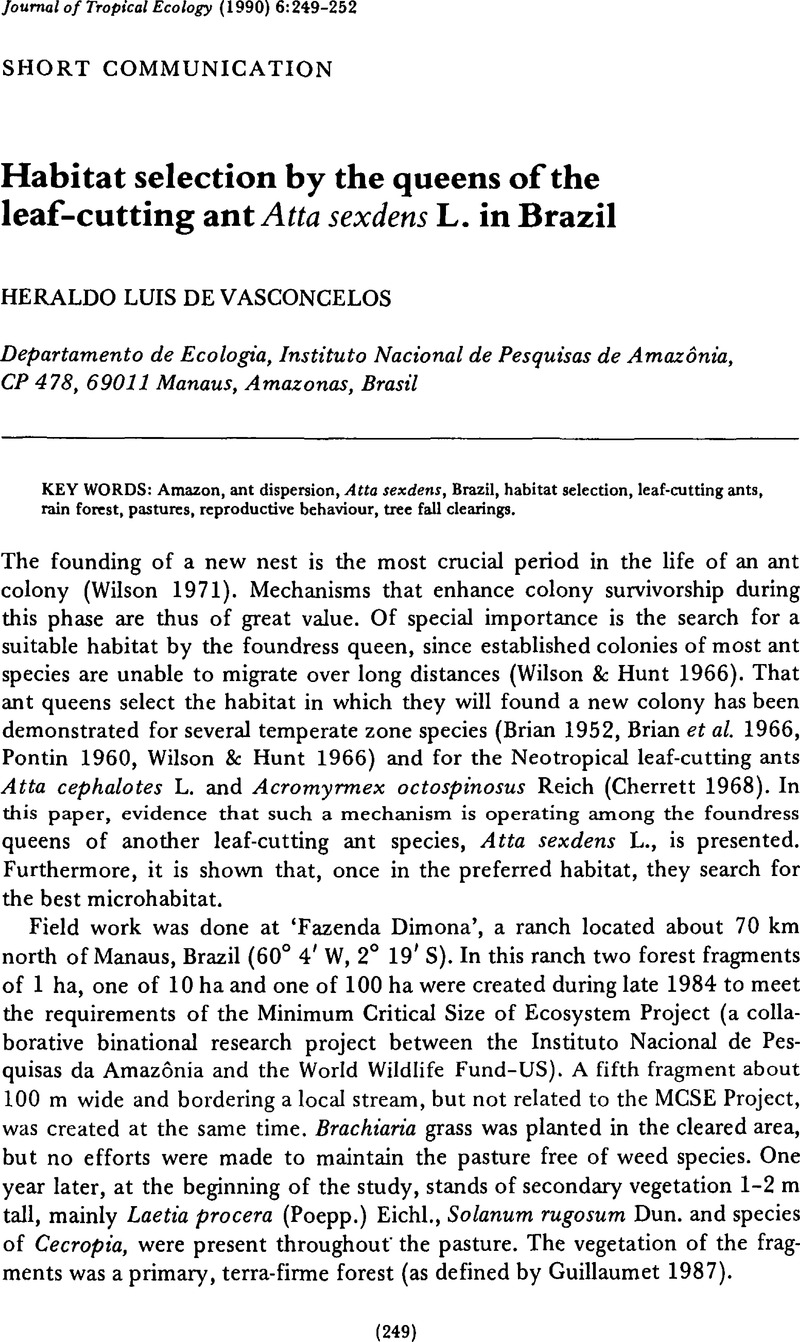Crossref Citations
This article has been cited by the following publications. This list is generated based on data provided by Crossref.
Nichols-Orians, Colin M.
1991.
The effects of light on foliar chemistry, growth and susceptibility of seedlings of a canopy tree to an attine ant.
Oecologia,
Vol. 86,
Issue. 4,
p.
552.
Offerman, Holly L.
Dale, Virginia H.
Pearson, Scott M.
O'Neill, Robert V.
and
Bierregaard Jr., Richard O.
1995.
Effects of forest fragmentation on neotropical fauna: current research and data availability.
Environmental Reviews,
Vol. 3,
Issue. 2,
p.
191.
Vasconcelos, Heraldo L.
and
Cherrett, J. Malcolm
1995.
Changes in leaf‐cutting ant populations (Formicidae: Attini) after the clearing of mature forest in Brazilian Amazonia.
Studies on Neotropical Fauna and Environment,
Vol. 30,
Issue. 2,
p.
107.
Farji-Brener, Alejandro G.
and
Medina, Claudia A.
2000.
The Importance of Where to Dump the Refuse: Seed Banks and Fine Roots in Nests of the Leaf-Cutting Ants Atta cephalotes and A. colombica1.
BIOTROPICA,
Vol. 32,
Issue. 1,
p.
120.
Farji‐Brener, Alejandro G.
and
Medina, Claudia A.
2000.
The Importance of Where to Dump the Refuse: Seed Banks and Fine Roots in Nests of the Leaf‐Cutting Ants Atta cephalotes and A. colombica1.
Biotropica,
Vol. 32,
Issue. 1,
p.
120.
Hull‐Sanders, Helen M.
and
Howard, Jerome J.
2003.
Impact of Atta colombica Colonies on Understory Vegetation and Light Availability in a Neotropical Forest1.
Biotropica,
Vol. 35,
Issue. 3,
p.
441.
Hull-Sanders, Helen M.
and
Howard, Jerome J.
2003.
Impact of Atta colombica Colonies on Understory Vegetation and Light Availability in a Neotropical Forest1.
BIOTROPICA,
Vol. 35,
Issue. 3,
p.
441.
Lopes, Benedito C.
2005.
Recursos vegetais usados por Acromyrmex striatus (Roger) (Hymenoptera, Formicidae) em restinga da Praia da Joaquina, Florianópolis, Santa Catarina, Brasil.
Revista Brasileira de Zoologia,
Vol. 22,
Issue. 2,
p.
372.
Vasconcelos, Heraldo L.
Vieira‐Neto, Ernane H. M.
Mundim, Fabiane M.
and
Bruna, Emilio M.
2006.
Roads Alter the Colonization Dynamics of a Keystone Herbivore in Neotropical Savannas1.
Biotropica,
Vol. 38,
Issue. 5,
p.
661.
Urbas, Pille
Araújo, Manoel V.
Leal, Inara R.
and
Wirth, Rainer
2007.
Cutting More from Cut Forests: Edge Effects on Foraging and Herbivory of Leaf‐Cutting Ants in Brazil.
Biotropica,
Vol. 39,
Issue. 4,
p.
489.
Farji-Brener, Alejandro G
and
Ghermandi, Luciana
2008.
Leaf-cutting ant nests near roads increase fitness of exotic plant species in natural protected areas.
Proceedings of the Royal Society B: Biological Sciences,
Vol. 275,
Issue. 1641,
p.
1431.
van Gils, H. A. J. A.
Gaigl, A.
and
Gómez, L. E.
2010.
The relationship between soil variables and leafcutter ant (Atta sexdens) nest distribution in the Colombian Amazon.
Insectes Sociaux,
Vol. 57,
Issue. 4,
p.
487.
Vieira‐Neto, Ernane H. M.
and
Vasconcelos, Heraldo L.
2010.
Developmental changes in factors limiting colony survival and growth of the leaf‐cutter ant Atta laevigata.
Ecography,
Vol. 33,
Issue. 3,
p.
538.
Van Gils, Heike A.J.A.
Gómez, Lilliam E.
and
Gaigl, Andreas
2011.
Atta sexdens (L.) (Hymenoptera: Formicidae) Demography in the Colombian Amazon: an Evaluation of the Palatable Forage Hypothesis.
Environmental Entomology,
Vol. 40,
Issue. 4,
p.
770.
MEYER, SEBASTIAN T.
LEAL, INARA R.
TABARELLI, MARCELO
and
WIRTH, RAINER
2011.
Ecosystem engineering by leaf-cutting ants: nests of Atta cephalotes drastically alter forest structure and microclimate.
Ecological Entomology,
Vol. 36,
Issue. 1,
p.
14.
Dohm, Christoph
Leal, Inara R.
Tabarelli, Marcello
Meyer, Sebastian T.
and
Wirth, Rainer
2011.
Leaf-cutting ants proliferate in the Amazon: an expected response to forest edge?.
Journal of Tropical Ecology,
Vol. 27,
Issue. 6,
p.
645.
Devigne, Cédric
and
de Biseau, Jean-Christophe
2012.
The differential response of workers and queens of the ant Lasius niger to an environment marked by workers: Ants dislike the unknown.
Behavioural Processes,
Vol. 91,
Issue. 3,
p.
275.
Gils, H. A. J. A. Van
and
Vanderwoude, C.
2012.
Leafcutter Ant (Atta sexdens) (Hymenoptera: Formicidae) Nest Distribution Responds to Canopy Removal and Changes in Micro-Climate in the Southern Colombian Amazon..
Florida Entomologist,
Vol. 95,
Issue. 4,
p.
914.
Leal, Inara R.
Wirth, Rainer
and
Tabarelli, Marcelo
2014.
The Multiple Impacts of Leaf‐Cutting Ants and Their Novel Ecological Role in Human‐Modified Neotropical Forests.
Biotropica,
Vol. 46,
Issue. 5,
p.
516.
Winston, Max E.
and
Herz, Hubert
2015.
Unpaved roads alter foraging patterns of the leafcutter antAtta colombica.
Studies on Neotropical Fauna and Environment,
Vol. 50,
Issue. 2,
p.
57.



